Before 1950
History of Korea Photography
The opening of the Korean photography era was around 1880. Between the 1860s and 70s, Eui-ik and Kyung-suk Oh and Kim Ki-soo and Kim Hong-jip were photographed in China and Japan, and centered on Ganghwado between France and the United States of Korea. The pictures of Byeongin Yang Yoo, Shin Mi Yang Yoo and portrait photos of seven surveyors and attendants who visited Japan in 1881 were taken by foreigners and the wave of photography culture was coming closer and faster.
Reference website: http://visualanguage.org/period
Emperor Gojong, Joseon
First Photo Studio in Korea
The beginning of the photography era begins when photographers who went to Japan and China between 1880 and 1884. They learned photography and came back to Korea then established a photography studio. Kim Ok-gyun, Young-Hyo Park, Gil-Jun Park, Gil-Jun Yoo, Jo-Pil Kim, Yoon-Sik Kim, Hong-Jip Min, Min-Hwan Min, and Yun Woong-Yeol were crystals of this era and played a significant role of Korean photography.

On 16 March, 1884 was the first monumental day in our history since Emperor Gojong who was the 26th king of Joseon, took pictures himself in front of the camera. This was recorded as an interesting event in our history and dealt with local newspapers at that time because from that time, our history was recorded with images in the palace and the civilians of Joseon started enjoying to take a photo in their general lives. Eventually, Emperor Gojong continued to take pictures frequently and became the king who left the most pictures in our history.
From the time of the introduction of the photo studio in Joseon, it became public and commercially settled. At first, it was called as a “chwal-yeong-gug (meaning: a filming country)”, but later the name of a “photo studio” was widely used. For us, the photo studio was considered a symbol of Western culture, because of this reason it was destroyed by an angry crowd during the Gapsin Coup (Gapsinjeongbyeon). It was very interesting that one of the reason why people in Joseon hesitated to take a photo and believed that when the photo was taken, the spirit or soul of a person was sucked to the camera.
In 1895, the photographs began to receive new attention due to the need of many people because they were forced to change their traditional appearance (cut their long hair). Afterwards, the photo studio contributed in the development of photographic culture until the 1940s. People took commemorative portrait photographs of marriage, engagement, 60th birthday (the biggest birthday party in their lives), and everyday records and landscape photographs.
The art photography which was developed between the 1920s and 1945s, photography was settled as a part of culture and used as a means of expression. The art photography movement was initially led by members of the Kyungsung Photographers Association that was a group of Korean photographers established in 1920s, became more popular and many photographers participated in 1930s. The art photography of this era may, at some point, awaken our traditional aesthetic sentiment. There were photographers such as Jeong Do-sun, Choi Gye-bok, and Jeong Hae-chang held the first private exhibition in Korea in 1929.


